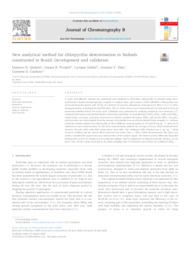New analytical method for chlorpyrifos determination in biobeds constructed in Brazil: Development and validation.
New analytical method for chlorpyrifos determination in biobeds constructed in Brazil: Development and validation.
Autoria: QUATRIN, G. D.; PIZZUTTI, I. R.; GEBLER, L.; DIAS, J. V.; CARDOSO, C. D.
Resumo: A quick and efficient method was optimized and validated to determine chlorpyrifos in biobeds using ultraperformance liquid chromatography coupled to tandem mass spectrometry (UPLC-MS/MS). Chlorpyrifos was extracted from the matrix with 30 mL of a mixture of acetone, phosphoric acid and water 98:1:1 (v/v/v). After homogenization, centrifugation and filtration, 125 μL of the extract was evaporated and reconstituted in 5 mL of methanol acidified with 0.1% acetic acid. Validation was performed by studying analytical curve linearity (r2), estimated instrument and method limits of detection and limits of quantification (LODi, LODm, LOQi and LOQm, respectively), accuracy, precision (expressed as relative standard deviation, RSD), and matrix effect. Accuracy and precision were determined from the amount of pesticide recovered from biobed blank samples (i.e. without pesticide residue) spiked with chlorpyrifos at three different concentrations (2, 10 and 50 mg kg−1), with seven replicates at each concentration. For all three concentrations studied, the average recovery values obtained were between 96 and 115% with RSD values lower than 20%. The validated LOQ obtained was 2 mg kg−1 (from recovery studies) and the matrix effect observed was lower than ± 20%, which demonstrated that there was neither considerable suppression nor enhancement of the analyte signal. The biobed system efficiently degraded chlorpyrifos in both 1) simulation of accidental spillage and 2) application of diluted pesticide solution. In the latter case, all the values obtained at the final sampling time (14 months) were below the validated LOQm.
Ano de publicação: 2020
Tipo de publicação: Artigo de periódico
Unidade: Embrapa Uva e Vinho
Palavras-chave: Biomixture, Method validation, Pesticide degradation, Solid phase bioreactor, UPLC–MS/MS
Observações
1 - Por padrão são exibidas publicações dos últimos 20 anos. Para encontrar publicações mais antigas, configure o filtro ano de publicação, colocando o ano a partir do qual você deseja encontrar publicações. O filtro está na coluna da esquerda na busca acima.
2 - Para ler algumas publicações da Embrapa (apenas as que estão em formato ePub), é necessário ter, no celular ou computador, um desses softwares gratuitos. Sistemas Android: Google Play Livros; IOS: iBooks; Windows e Linux: software Calibre.
Acesse outras publicações
Acesse a Base de Dados da Pesquisa Agropecuária (BDPA) para consultar o acervo completo das bibliotecas da Embrapa.

